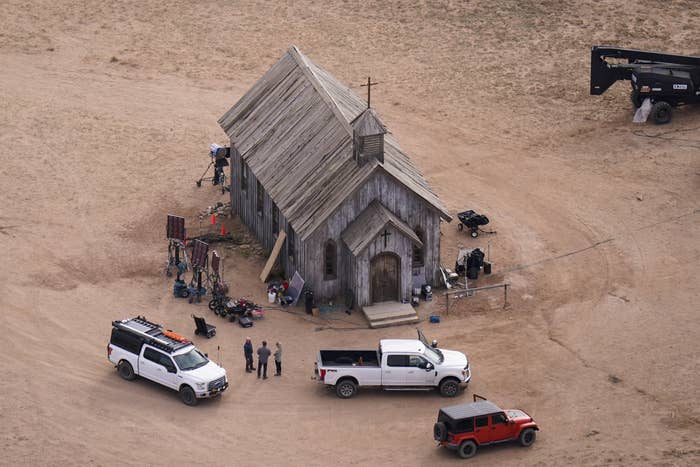
Alec Baldwin will be charged with two counts of involuntary manslaughter more than a year after he accidentally shot and killed cinematographer Halyna Hutchins while filming the Western Rust.
The film's armorer, Hannah Gutierrez-Reed, will also be charged with two counts of involuntary manslaughter, prosecutors in Santa Fe, New Mexico, announced Thursday.
Assistant director Dave Halls, who green-lit the use of the gun as safe, has agreed to plead guilty to negligent use of a deadly weapon under the terms of a suspended sentence and six months of probation, prosecutors said.
"After a thorough review of the evidence and the laws of the state of New Mexico, I have determined that there is sufficient evidence to file criminal charges against Alec Baldwin and other members of the ‘Rust’ film crew," New Mexico First Judicial District Attorney Mary Carmack-Altwies said in a statement.
Baldwin and Gutierrez-Reed will be "charged in the alternative" with both counts of manslaughter that they each face. That means a jury will decide whether they are guilty, and under which definition of involuntary manslaughter.
Jurors will be tasked with deciding if there is underlying negligence in the first charge, and whether there was more than simple negligence involved in Hutchins's death in the second charge.
Each involuntary manslaughter charge carries up to 18 months in jail and a $5,000 fine. The second charge includes an added five-year mandatory jail sentence because a firearm was involved.
In a statement released via his attorney, Hutchins's husband, Matt Hutchins, thanked prosecutors and the Santa Fe Sheriff's Office.
"It is a comfort to the family that, in New Mexico, no one is above the law," the statement read. "We support the charges, will fully cooperate with this prosecution, and fervently hope the justice system works to protect the public and hold accountable those who break the law."
The Oct. 21, 2021, tragedy rocked Hollywood and sparked increased scrutiny of the practice of using prop guns as industry workers lamented that they had long complained about dangerous working conditions on lower-budget films like Rust. The shooting took place as the cast and crew were rehearsing with the equipment at the Bonanza Creek Ranch in Santa Fe.
According to court documents, Halls, the assistant director, picked up one of the prop guns that was sitting on a cart outside, yelled, “Cold gun!” — meaning that the weapon was safe to use — and handed it to Baldwin not knowing it contained live rounds.
Baldwin then discharged the revolver while pointing the gun at the camera, striking Hutchins and then the film’s director, Joel Souza. Hutchins was airlifted to a hospital where she was pronounced dead, while Souza was treated for his injury and released.
The actor has said that he pulled back the gun's hammer, but he did not pull the trigger. He also maintained that gun safety on the set was not his responsibility. In a statement to BuzzFeed News, Baldwin's attorney Luke Nikas reiterated that Baldwin had "relied on the professionals" who had "assured him the gun did not have live rounds."
“This decision distorts Halyna Hutchins’ tragic death and represents a terrible miscarriage of justice," Nikas said. "Mr. Baldwin had no reason to believe there was a live bullet in the gun – or anywhere on the movie set. ... We will fight these charges, and we will win.”
Text messages obtained by the sheriff’s office show that Baldwin suggested there was a "sabotage" attempt happening, telling Matt Hutchins days after the shooting that he believed the gun was empty and that it "was never meant to be fired in that camera angle."
"The Santa Fe Sheriffs office may lack both the skill and the will to properly investigate the sabotage angle," he wrote.
Prosecutors said they are not pursuing charges over the shooting of Souza.

In the weeks leading up to the shooting, crew members repeatedly raised concerns about safety issues, including that there had been multiple accidental discharges, but they were ignored, according to a lawsuit filed by Hutchins's family. The morning she died, her camera crew had gone on strike in part because of safety issues with weapons.
During their investigation, Santa Fe sheriff's officials tried to determine how live ammunition, which under best practices should never even be present on a film set, ended up at the ranch. According to documents previously released by the sheriff's office, live and "dummy" rounds may have been mixed together in a box. So-called dummy rounds contain no explosives or propellants and are used as stand-ins for real bullets.
Gutierrez-Reed, the armorer tasked with overseeing the weapons on set, and her father, Thell Reed, a well-known armorer, told investigators the live rounds might have come from weapons expert Seth Kenney, who was not on set but provided some of the ammunition materials that were used for production.
Kenney told investigators that the ammunition he provided included dummy rounds and blanks, which he got from a manufacturer called Starline Brass. The manufacturer doesn't sell live ammunition, he said, according to an affidavit released in November 2021. But Kenney said he had previously received “reloaded ammunition” from a friend that had “stuck out to him” because the cartridge had the Starline Brass logo on it. The round, apparently reloaded with components to become live, would have looked similar to the other Starline Brass rounds he provided to the set.
Gutierrez-Reed, who came under scrutiny for her limited experience, told investigators that she and Sarah Zachry, the Rust prop master, had checked and loaded the guns earlier in the day before the shooting and did not thoroughly scan them again after the crew had broken for lunch. Gutierrez-Reed said she put what she believed were five dummy rounds into the long-barrel Colt .45, which Baldwin would eventually use to accidentally kill Hutchins and injure Souza.

After they finished eating, Zachry took the gun from the safe and handed it to Gutierrez-Reed, who turned her attention to one round that wouldn’t go in. She cleaned it out and put in another round, bringing the total to six. The guns were checked, she told investigators, but she reiterated that she “didn’t really check [the firearm] too much” because it had been locked up over lunch.
Zachry told investigators that after the shooting, she checked the box of ammunition in the props cart to compare it to some of the others. She noticed that some of the cartridges in the box would rattle, which meant they were dummy rounds. However, others did not, which led her to believe that some were live ammunition.
Before receiving the sheriff's full investigative report in October, Carmack-Altwies had requested $635,500 in order to pay for potentially four separate trials and a special prosecutor, the Los Angeles Times reported. The state ultimately awarded her $317,000, or about half of what she had requested.
In the Aug. 30 letter to the state's finance board, Carmack-Altwies said Baldwin was among the four people she was considering charging and that the expenses for the potential prosecution would be "costly." She did not name the other possible defendants at the time.

